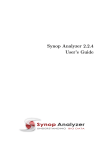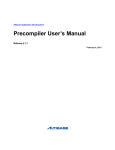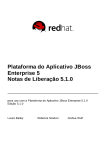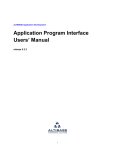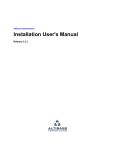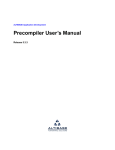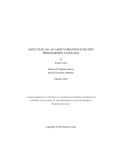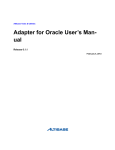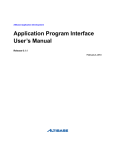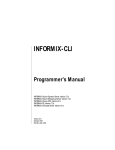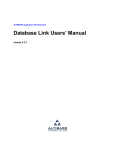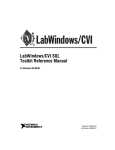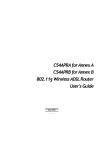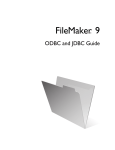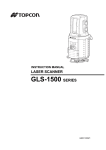Download Getting Started Guide - ALTIBASE Customer Support
Transcript
Altibase Administration Getting Started Guide Release 5.5.1 January 17, 2013 Altibase Administration Getting Started Guide Release 5.5.1 Copyright © 2001~2009 Altibase Corporation. All rights reserved. This manual contains proprietary information of Altibase® Corporation; it is provided under a license agreement containing restrictions on use and disclosure and is also protected by copyright patent and other intellectual property law. Reverse engineering of the software is prohibited. All trademarks, registered or otherwise, are the property of their respective owners Altibase Corporation 10F, Daerung PostTower II, 182-13, Guro-dong Guro-gu Seoul, 152-847, Korea Telephone: +82-2-2082-1000 Fax: 82-2-2082-1099 E-mail: [email protected] www: http://www.altibase.com Contents Preface ............................................................................................................................................................................. i About This Manual ....................................................................................................................................................................................ii Audience........................................................................................................................................................................................ii Software Environment..............................................................................................................................................................ii Organization.................................................................................................................................................................................ii Documentation Conventions ...............................................................................................................................................iii Related Documents ...................................................................................................................................................................v On-line Manuals..........................................................................................................................................................................v Altibase Welcomes Your Comments..................................................................................................................................vi 1. Installing ALTIBASE HDB ...........................................................................................................................................1 1.1 The Installation Process....................................................................................................................................................................2 1.1.1 Download the Package Installer.................................................................................................................................2 1.1.2 Run the Package Installer..............................................................................................................................................2 1.1.3 Provide a License Key .....................................................................................................................................................2 1.1.4 Create a Database............................................................................................................................................................2 1.2 Special Considerations .....................................................................................................................................................................3 1.2.1 Considerations when Installing ALTIBASE HDB in UNIX....................................................................................3 1.2.2 Considerations when Installing ALTIBASE HDB in Windows ...........................................................................3 2. Startup and Shutdown ..............................................................................................................................................5 2.1 Startup ....................................................................................................................................................................................................6 2.2 Shutting Down ALTIBASE HDB ......................................................................................................................................................8 2.2.1 immediate .........................................................................................................................................................................8 2.2.2 abort ....................................................................................................................................................................................9 3. Working with ALTIBASE HDB ..................................................................................................................................11 3.1 Supported SQL Statements ......................................................................................................................................................... 12 3.2 How to Execute SQL Statements ............................................................................................................................................... 13 3.2.1 Executing SQL Statements using the iSQL Utility ............................................................................................. 13 3.2.2 Executing SQL Statements using the AdminCenter Utility .......................................................................... 13 3.2.3 Executing SQL Statements using Custom-Authored Client Applications................................................ 13 3.3 The Sample Schema ....................................................................................................................................................................... 14 4. DB Objects and Privileges .......................................................................................................................................15 4.1 Database Objects: An Overview................................................................................................................................................. 16 4.1.1 Schema Objects............................................................................................................................................................. 16 4.1.2 Non-schema Objects ................................................................................................................................................... 18 4.2 Privileges............................................................................................................................................................................................. 20 4.2.1 Managing Privileges .................................................................................................................................................... 20 4.2.2 Granting Privileges ....................................................................................................................................................... 20 4.2.3 Revoking Privileges ...................................................................................................................................................... 20 5. Multilingual Features ..............................................................................................................................................21 5.1 Multilingual Support Overview .................................................................................................................................................. 22 5.1.1 Concept ............................................................................................................................................................................ 22 5.1.2 Related Terminology ................................................................................................................................................... 22 5.1.3 Multilingual Support.................................................................................................................................................... 22 5.2 Character Set Classification for Multilingual Support ........................................................................................................ 25 5.2.1 Database Character Set .............................................................................................................................................. 25 5.2.2 National Character Set ................................................................................................................................................ 25 5.2.3 Client Character Set...................................................................................................................................................... 26 5.3 Using Unicode .................................................................................................................................................................................. 27 5.3.1 The Unicode Concept.................................................................................................................................................. 27 5.3.2 Unicode Encoding ........................................................................................................................................................ 27 5.3.3 Storing Unicode Characters ...................................................................................................................................... 27 5.3.4 A Unicode Database .................................................................................................................................................... 27 5.3.5 Unicode Datatypes....................................................................................................................................................... 28 5.4 Making Environment Settings for a Multilingual Database ............................................................................................. 29 5.4.1 Setting Environment Variables ................................................................................................................................ 29 iii 5.4.2 Example............................................................................................................................................................................ 30 5.5 Considerations when Choosing a Database Character Set.............................................................................................. 32 5.5.1 Scope of Usage .............................................................................................................................................................. 32 5.5.2 One Restriction .............................................................................................................................................................. 32 5.5.3 Effects of Character Set Conversion ....................................................................................................................... 33 6. Database Replication...............................................................................................................................................35 6.1 Introduction to Replication.......................................................................................................................................................... 36 6.2 How Databases Are Replicated in ALTIBASE HDB ............................................................................................................... 37 6.2.1 Establishing a Replication Environment............................................................................................................... 37 6.3 How to Replicate a Database ...................................................................................................................................................... 38 6.3.1 Creating Replication Objects .................................................................................................................................... 38 6.3.2 Starting Replication...................................................................................................................................................... 38 6.3.3 Stopping Replication ................................................................................................................................................... 38 6.3.4 Resetting Replication................................................................................................................................................... 38 6.3.5 Dropping Tables............................................................................................................................................................ 39 6.3.6 Adding Tables ................................................................................................................................................................ 39 6.3.7 Dropping a Replication Object ................................................................................................................................ 39 6.4 Executing DDL Statements in a Replication Environment ............................................................................................... 40 7. Fail-Over ...................................................................................................................................................................41 7.1 About Fail-Over ............................................................................................................................................................................... 42 7.1.1 The Fail-Over Concept................................................................................................................................................. 42 7.2 How to Use Fail-Over...................................................................................................................................................................... 44 7.2.1 Setting the Fail-Over Connection Property......................................................................................................... 44 7.2.2 Checking Whether Fail-Over Has Succeeded ..................................................................................................... 44 7.2.3 How to Write a Fail-Over Callback Function ....................................................................................................... 44 8. Backup and Recovery ..............................................................................................................................................47 8.1 ALTIBASE HDB Backup Policy ...................................................................................................................................................... 48 8.2 ALTIBASE HDB Recovery Policy .................................................................................................................................................. 49 9. Developing ALTIBASE HDB Applications ...............................................................................................................51 9.1 Writing Client Application Programs........................................................................................................................................ 52 9.2 Using ALTIBASE HDB ODBC APIs................................................................................................................................................ 53 9.2.1 Header Files and Libraries.......................................................................................................................................... 53 9.2.2 Makefile ............................................................................................................................................................................ 53 9.2.3 Multi-threaded Programming.................................................................................................................................. 53 9.2.4 Writing Applications .................................................................................................................................................... 53 9.3 Applications Using JDBC............................................................................................................................................................... 59 9.3.1 JDBC Driver...................................................................................................................................................................... 59 9.3.2 CLASSPATH ..................................................................................................................................................................... 59 9.3.3 Writing Applications .................................................................................................................................................... 59 9.4 Applications Using ODBC with MS Windows ........................................................................................................................ 62 9.4.1 Installing the ODBC Driver......................................................................................................................................... 62 9.4.2 Writing Applications .................................................................................................................................................... 64 9.5 Applications Written Using the C/C++ Precompiler........................................................................................................... 68 9.5.1 Environment Settings.................................................................................................................................................. 68 9.5.2 Precompiling .................................................................................................................................................................. 68 9.5.3 Multi-threaded Programming.................................................................................................................................. 69 9.5.4 Writing Applications .................................................................................................................................................... 69 iv Preface i Preface About This Manual About This Manual This manual explains the concepts, components, and basic use of ALTIBASE® HDB™ . Audience This manual has been prepared for the following users of ALTIBASE HDB: • database managers • performance managers • database users • application developers • technical support workers It is recommended that those reading this manual possess the following background knowledge: • basic knowledge in the use of computers, operating systems, and operating system utilities • experience in using relational databases and an understanding of database concepts • computer programming experience • experience in database server, operating system or network administration Software Environment This manual has been prepared assuming that ALTIBASE HDB 5.5.1 will be used as the database server. Organization This manual is organized as follows: • Chapter1: Installing ALTIBASE HDB • Chapter2: Startup and Shutdown • Chapter3: Working with ALTIBASE HDB • Chapter4: DB Objects and Privileges • Chapter5: Multilingual Features This chapter describes the structure of the multilingual features and related environment settings, and notes some relevant considerations. • Chapter6: Database Replication This chapter describes the replication environment and how to perform replication. Getting Started Guide ii About This Manual • Chapter7: Fail-Over • Chapter8: Backup and Recovery • Chapter9: Developing ALTIBASE HDB Applications This chapter introduces each API (Application Programming Interface): ODBC, JDBC, C/C++ Precompiler, etc. Documentation Conventions This section describes the conventions used in this manual. Understanding these conventions will make it easier to find information in this manual and other manuals in the series. There are two sets of conventions: • syntax diagrams • sample code conventions Syntax diagrams This manual describes command syntax using diagrams composed of the following elements: Elements semantics The command starts. The syntax element which is not a complete command starts with an arrow. Reserved word The command continues to the next line. The syntax element which is not a complete command terminates with this symbol. The command continues from the previous line. The syntax element which is a complete command starts with this symbol. End of the statement. ; Mandatory SELECT iii Preface About This Manual Elements semantics Optional NOT Mandatory field with optional items. Only one field must be provided. ADD DROP Optional field with optional item ASC DESC Optional multiple fields are allowed. The comma must be in front of every repetition. ASC DESC , Sample Code Conventions The code examples explain SQL, stored procedures, iSQL, and other command line syntax. The following table describes the printing conventions used in the code examples. Rules Semantics Example [] Indicates optional fields. VARCHAR [(size)] [[FIXED |] VARIABLE] {} Indicates mandatory fields. Indicates to make sure to select at least one. { ENABLE | DISABLE | COMPILE } | Argument indicating optional or mandatory fields { ENABLE | DISABLE | COMPILE } [ ENABLE | DISABLE | COMPILE ] Getting Started Guide iv About This Manual Rules Semantics Example . . . Repetition of the previous argument.Omit the example codes. iSQL> select e_lastname from employees; E_LASTNAME -----------------------Moon Davenport Kobain . . . 20 rows selected. Other symbols Other symbols EXEC :p1 := 1; acc NUMBER(11,2); Italicized words Indicates variable or value that must be provided by user. SELECT * FROM table_name; CONNECT userID/password; Lower case words Program elements provided by the user such as table names, column names, file names, etc. SELECT e_lastname FROM employees; Upper case words Elements provided by the system or keyword appeared in the syntax. DESC SYSTEM_.SYS_INDICES_; Related Documents For more detailed information, please refer to the following documents: • ALTIBASE HDB Installation Guide • ALTIBASE HDB Administrator’s Manual • ALTIBASE HDB Replication Manual • ALTIBASE HDB Precompiler User’s Manual • ALTIBASE HDB ODBC Reference • ALTIBASE HDB Application Program Interface User’s Manual • ALTIBASE HDB iSQL User’s Manual • ALTIBASE HDB Utilities Manual • ALTIBASE HDB Error Message Reference On-line Manuals Manuals are available at Altibase Technical Center (http://atc.altibase.com/). v Preface About This Manual Altibase Welcomes Your Comments Please let us know what you like or dislike about our manuals. To help us with future versions of our manuals, please tell us about any corrections or classifications that you would find useful. Include the following information : • The name and version of the manual that you are using • Any comments that you have about the manual • Your name, address, and phone number Write to us at the following electronic mail address : [email protected] When you need an immediate assistance regarding technical issues, please contact Altibase Technical Center. Thank you. We appreciate your feedback and suggestions. Getting Started Guide vi 1 Installing ALTIBASE HDB This chapter provides only a brief overview of the installation procedure. For complete instructions on how to install ALTIBASE HDB server, it is strongly recommended that you consult the ALTIBASE HDB Installation Guide. This chapter contains the following sections: 1.1 The Installation Process 1.2 Special Considerations 1 Installing ALTIBASE HDB 1.1 The Installation Process 1.1 The Installation Process 1.1.1 Download the Package Installer Visit altibase.com and download the installer that is suitable for your operating system. 1.1.2 Run the Package Installer When the package installer is executed, the following tasks are performed automatically: 1.1.2.1 Create the ALTIBASE_HOME Directory This is the directory that contains the executable files, configuration files, and by default, the data and log files. The package installer gives you the opportunity to specify this directory. 1.1.2.2 Set the ALTIBASE HDB Property Values The package installer suggests default property settings, and gives you the opportunity to change them as desired. These properties can be changed after installation is complete by modifying the altibase.properties file, which is located at ALTIBASE_HOME/conf/altibase.properties. 1.1.2.3 Create a Database Creation Script The package installer can be used to create a script that you can later execute to create a database automatically, which greatly simplifies the database creation task. 1.1.3 Provide a License Key There are two ways to provide a license key: either by entering the license key directly, or by selecting a file containing license key information. 1.1.4 Create a Database After installation is complete, it will be necessary to create a database. If you created a database creation script using the package installer, you can execute this script and a database will be created for you automatically. Getting Started Guide 2 1.2 Special Considerations 1.2 Special Considerations 1.2.1 Considerations when Installing ALTIBASE HDB in UNIX 1.2.1.1 Configuring Kernel Parameters If system kernel parameters were not set during installation, set the parameters manually. 1.2.2 Considerations when Installing ALTIBASE HDB in Windows 1.2.2.1 You Must Be Logged On as an Administrator The ALTIBASE HDB Package Installer registers the ODBC driver of ALTIBASE HBD, registers the ALTIBASE HDB server as a Windows service, and starts the service. Only administrators can register the ODBC driver, register the process as a Windows service, and start the service. 3 Installing ALTIBASE HDB 1.2 Special Considerations Getting Started Guide 4 2 Startup and Shutdown This chapter explains how to start up and shut down ALTIBASE HDB after it has been properly installed. This chapter contains the following sections: 2.1 Startup 2.2 Shutting Down ALTIBASE HDB 5 Startup and Shutdown 2.1 Startup 2.1 Startup The ALTIBASE HDB server can be started up in one of two ways: either using a server script, or when a DBMS administrator logs in using the sys account, accesses the DBMS in sysdba administrator mode, and explicitly starts ALTIBASE HDB. To explain the ALTIBASE HDB server startup process, first, the properties are read and system memory is checked, and then the system environment of ALTIBASE HBD is initialized, system data are initialized, signal handling is initialized, the memory used for database space is initialized, the Query Processor is initialized, and finally, the threads are initialized. This completes ALTIBASE HDB server startup. The command to start up ALTIBASE HDB can only be given using the Unix account with which ALTIBASE HDB was installed. The following shows how to start up a database using the iSQL utility, which ships with ALTIBASE HDB. For more information on the iSQL utility, please refer to the ALTIBASE HDB iSQL User’s Manual. $ isql -u sys -p manager -sysdba ------------------------------------------------------Altibase Client Query utility. Release Version 6.1.1.1 Copyright 2000, ALTIBASE Corporation or its subsidiaries. All Rights Reserved. ------------------------------------------------------ISQL_CONNECTION = UNIX, SERVER = 127.0.0.1, PORT_NO = 20300 iSQL(sysdba)> iSQL(sysdba)> startup Connecting to the DB server.... Connected. TRANSITION TO PHASE : PROCESS TRANSITION TO PHASE : CONTROL TRANSITION TO PHASE : META [SM] Recovery Phase - 1 : Preparing Database : Dynamic Memory Version => Parallel Loading [SM] Recovery Phase - 2 : Loading Database [SM] Recovery Phase - 3 : Skipping Recovery & Starting Threads... Refining Disk Table [SM] Refine Memory Table : ..................................................... [SUCCESS] [SM] Rebuilding Indices [Total Count:100] ............................... [SUCCESS] TRANSITION TO PHASE : SERVICE [CM] Listener started : TCP on port 20300 [CM] Listener started : UNIX [RP] Initialization : [PASS] --- STARTUP Process SUCCESS --Command execute success. The following shows how to start up a database using a server script. $ server start ------------------------------------------------------Altibase Client Query utility. Release Version 6.1.1.1 Copyright 2000, ALTIBASE Corporation or its subsidiaries. All Rights Reserved. Getting Started Guide 6 2.1 Startup ------------------------------------------------------ISQL_CONNECTION = UNIX, SERVER = 127.0.0.1, PORT_NO = 20300 [ERR-910FB : Connected to idle instance] Connecting to the DB server... Connected. TRANSITION TO PHASE : PROCESS TRANSITION TO PHASE : CONTROL TRANSITION TO PHASE : META [SM] Recovery Phase - 1 : Preparing Database : Dynamic Memory Version => Parallel Loading [SM] Recovery Phase - 2 : Loading Database [SM] Recovery Phase - 3 : Skipping Recovery & Starting Threads... Refining Disk Table [SM] Refine Memory Table : ....................................................... [SUCCESS] [SM] Rebuilding Indices [Total Count:100] .................................. [SUCCESS] TRANSITION TO PHASE : SERVICE [CM] Listener started : TCP on port 20300 [CM] Listener started : UNIX [RP] Initialization : [PASS] --- STARTUP Process SUCCESS --Command execute success. 7 Startup and Shutdown 2.2 Shutting Down ALTIBASE HDB 2.2 Shutting Down ALTIBASE HDB The ALTIBASE HDB server can be shut down either using a server script or when a user with DBMS administrator privileges uses iSQL to shut down ALTIBASE HDB as the sys user (with the -sysdba parameter). The “shutdown” command, which is the command that is used to shut down the server, has three mutually exclusive options. The way in which the server is shut down is different for each option. The shutdown command of ALTIBASE HDB can only be given from the account used to install ALTIBASE HDB. normal In order for the server to shut down normally, the server must first wait until all clients have disconnected. If server shutdown is initiated while some tasks are still underway, the server waits for processes to terminate in the following order: first threads that sense client-server communication are shut down, followed by service threads, the Data Storage Manager, and finally the ALTIBASE HDB server process. At this time, the ALTIBASE HDB server has been completely shut down. When the server is shut down in this way, the following message is output. iSQL(sysdba)> shutdown normal Ok..Shutdown Proceeding.... TRANSITION TO PHASE : Shutdown Altibase [RP] Finalization : PASS shutdown normal success. 2.2.1 immediate When the immediate shutdown option is used, before the server is shut down, connected sessions are forcibly disconnected, and then current transactions are forcibly rolled back. The output for immediate shutdown is as follows: iSQL(sysdba)> shutdown immediate Ok..Shutdown Proceeding.... TRANSITION TO PHASE : Shutdown Altibase [RP] Finalization : PASS shutdown immediate success. The server can also be forcibly shut down using a server script command. $ server stop ------------------------------------------------------Altibase Client Query utility. Release Version 6.1.1.1 Copyright 2000, ALTIBASE Corporation or its subsidiaries. All Rights Reserved. ------------------------------------------------------ISQL_CONNECTION = UNIX, SERVER = 127.0.0.1, PORT_NO = 20300 Ok..Shutdown Proceeding.... TRANSITION TO PHASE : Shutdown Altibase [RP] Finalization : PASS shutdown immediate success. Getting Started Guide 8 2.2 Shutting Down ALTIBASE HDB 2.2.2 abort This option forces termination of an ALTIBASE HDB server with the system command ‘kill -9’. When ALTIBASE HDB is shut down in this way, the database may not be closed properly, and thus database recovery will need to be performed when ALTIBASE HDB is restarted. When the abort option is used, the following is output: iSQL(sysdba)> shutdown abort iSQL(sysdba)> The server can also be forcibly shut down using a server script command. $ server kill ------------------------------------------------------Altibase Client Query utility. Release Version 6.1.1.1 Copyright 2000, ALTIBASE Corporation or its subsidiaries. All Rights Reserved. ------------------------------------------------------ISQL_CONNECTION = UNIX, SERVER = 127.0.0.1, PORT_NO = 20300 $ 9 Startup and Shutdown 2.2 Shutting Down ALTIBASE HDB Getting Started Guide 10 3 Working with ALTIBASE HDB This chapter contains the following sections: 3.1 Supported SQL Statements 3.2 How to Execute SQL Statements 3.3 The Sample Schema 11 Working with ALTIBASE HDB 3.1 Supported SQL Statements 3.1 Supported SQL Statements Now that you have created a database and know how to start it up and shut it down, you will of course want to execute some SQL statements, starting with DDL statements for creating other users and database objects such as tables, and then DML statements to populate the tables with data and perform similar actions. For a description of the various kinds of available database objects, please refer to Chapter4: DB Objects and Privileges. ALTIBASE HDB Server supports the complete ANSI 92 SQL standard, and additionally provides some extended functionality. For a complete description of all SQL statements that are supported by ALTIBASE HDB Server, please refer to the SQL Reference. Getting Started Guide 12 3.2 How to Execute SQL Statements 3.2 How to Execute SQL Statements 3.2.1 Executing SQL Statements using the iSQL Utility The most straightforward way to execute SQL statements is to use the iSQL utility, which is a command-line interface that ships with ALTIBASE HDB. For complete information on how to use the iSQL utility, please refer to the iSQL User’s Manual. 3.2.2 Executing SQL Statements using the AdminCenter Utility SQL statements can also be executed using the AdminCenter utility, which can be downloaded from altibase.com. For complete information on the functionality offered by the AdminCenter utility, please refer to the AdminCenter User’s Manual. 3.2.3 Executing SQL Statements using Custom-Authored Client Applications Additionally, SQL statements can also be executed using custom-authored client applications. The point of entry for complete information on authoring applications for use with ALTIBASE HDB is Chapter 9 of this manual (**XREF??). 13 Working with ALTIBASE HDB 3.3 The Sample Schema 3.3 The Sample Schema The ALTIBASE HDB server package includes a script, which, when executed, creates a sample schema that includes a series of database tables and other objects, and populates the tables with sample data. Simply execute the script, which is located at ALTIBASE_HOME/sample/APRE/schema/ schema.sql, and the sample schema is created for you. Many of the examples in the product documentation are based on this sample schema. If you wish to follow along with the examples, or simply need some sample data on which to execute SQL statements for practice, it is recommended that you execute the above script to create the sample schema. For a complete description of all of the objects and data in the sample schema, please refer to the ALTIBASE HDB General Reference. Getting Started Guide 14 4 DB Objects and Privileges In this chapter, schema objects and non-schema objects will be classified, and the database objects in each category will be explained. This chapter contains the following sections: 4.1 Database Objects: An Overview 4.2 Privileges 15 DB Objects and Privileges 4.1 Database Objects: An Overview 4.1 Database Objects: An Overview Database objects can be divided into schema objects, which belong to certain schema, and nonschema objects, which do not have any relationship with particular schema. In this chapter, schema objects and non-schema objects will be classified, and the database objects in each category will be explained. 4.1.1 Schema Objects Schemas are logical collections of data and objects. Relational schemas are grouped by database user ID and include tables, views, and other objects. A user owns a schema and manages it using SQL statements. The objects included in schemas are called schema objects. ALTIBASE HDB supports the following schema objects: 4.1.1.1 Tables A table is the basic unit for storing data, and is a set of records consisting of columns. ALTIBASE HDB tables are divided into memory tables and disk tables depending on how the data are stored, and are also divided, based on who creates them, into system tables, which are created and managed by the system, and user tables, which are created by general users. System tables are also called the “data dictionary”. For detailed information about the data dictionary provided with ALTIBASE HDB, as well as data dictionary management issues, please refer to the Data Dictionary in Chapter 2 of the General Reference. Additionally, replication target tables and large volume tables also have special issues related to their management. For more detailed information than can be found here, the portion of the Administrator’s Manual pertaining to database objects describes in great detail how to manage them. 4.1.1.2 Queue Tables ALTIBASE HDB supports asynchronous data communication between user applications and the database using message queuing functionality. Queue tables are manipulated using DML and DDL statements, just like other database tables. For more information on the concepts and functionality of queue tables, please refer to the portion of the Administrator's Manual pertaining to database objects. 4.1.1.3 Constraints Constraints serve to restrict data manipulation in order to maintain data consistency when data are inserted into tables, or when existing data in tables are changed. Depending on the target of the constraints, constraints are divided into column constraints and table constraints. ALTIBASE HDB supports the following kinds of constraints. • NULL/NOT NULL Constraints • Unique Key Constraints Getting Started Guide 16 4.1 Database Objects: An Overview • Primary Key Constraints • Foreign Key Constraints • TIMESTAMP Constraints For more detailed information than can be found here, please refer to the portion of the Administrator's Manual pertaining to constraints. 4.1.1.4 LOB LOB (Large Object) is a data type that is intended for storing large data, such as documents or image files. The maximum size of a LOB data object that can be saved is 2 GB minus one byte. A table can have more than one LOB type data column. The LOB data type can be divided into the Binary Large Object (BLOB), which can hold binary data such as images and video files, and the Character Large Object (CLOB), which can hold string data. For more information on LOB management, please refer to the LOB data type portion of the General Reference. 4.1.1.5 Indexes Indexes are elements that allow records within tables to be accessed more quickly. Indexes are created within tables and increase the performance with which DML statements are processed. For more information, please refer to the portion of the Administrator’s Manual dealing with indexes. 4.1.1.6 Views A view does not contain actual data, but is a logical table created on the basis of one or more tables or views. (At this time, updatable views and materialized views are not supported by ALTIBASE HDB.) For more information, please refer to the portion of the ALTIBASE HDB Administrator’s Manual pertaining to views. 4.1.1.7 Sequences ALTIBASE HDB provides sequences for generating unique keys. For more information, please refer to the portion of the ALTIBASE HDB Administrator’s Manual pertaining to sequences. 4.1.1.8 Stored Procedures and Functions A stored procedure is a kind of database object in which all kinds of operations, such as SQL statements, stream control statements, assignment statements, and error handling routines, are programmatically combined into a single module that is permanently stored in the database, after which all of the operations stored therein can be executed merely by calling the stored procedure using its name. For more information, please refer to the portions of the Administrator’s Manual pertaining to stored procedures and stored functions. Additionally, for detailed information about the special features of stored procedures as provided 17 DB Objects and Privileges 4.1 Database Objects: An Overview with ALTIBASE HDB, as well as how to manage them, please refer to the Stored Procedures Manual. 4.1.1.9 Type Sets A type set is a database object which allows a number of user-defined data types that are used by stored procedures and stored functions to be grouped together in one place for convenient management. For more about type sets, please refer to the ALTIBASE HDB Stored Procedures Manual. 4.1.1.10 Database Triggers A trigger is a kind of stored procedure that is called automatically by the system when data in a table are inserted, deleted, or updated, thus allowing a specific set of tasks to be automatically performed. By defining constraints and triggers for tables, the user can maintain data consistency. For more information, please refer to the portion of the Administrator’s Manual pertaining to triggers. 4.1.1.11 Database Link Database Link allows database servers that are geographically distributed but connected via a network to be linked together to combine the data thereon and output a single result. 4.1.2 Non-schema Objects Objects that do not belong to any particular schema and are thus managed at the level of the entire database are called non-schema objects. ALTIBASE HDB provides the following non-schema objects: 4.1.2.1 Replication Replication can be thought of as a kind of object that allows information to be automatically sent from a local server to a remote server so that the data in tables on multiple servers can be kept consistent. For more details on replication, please refer to the Replication Manual. 4.1.2.2 Tablespaces The tablespace is the largest logical data storage unit. A database comprises, and manages, multiple tablespaces. ALTIBASE HDB automatically creates a system tablespace when a database is created, and the user creates user-defined tablespaces as desired. ALTIBASE HDB supports 3 types of tablespaces: disk tablespace, which resides on disk, memory tablespace, which resides in memory, and volatile tablespace, which also resides in memory but differs from memory tablespace in that logging is not performed. For more information on tablespace management, please refer to the portion of the Administrator’s Manual entitled “Managing Tablespace”. Getting Started Guide 18 4.1 Database Objects: An Overview 4.1.2.3 Partitioned Table When a table is partitioned, the table is called a partitioned table. A partitioned table is a large table that has been divided into several partitions based on the partitioning conditions (range, list and hash). For more information, please refer to the portion of the Administrator’s Manual pertaining to partitioned tables. 4.1.2.4 Partitioned Index Indexes are categorized as partitioned indexes or non-partitioned indexes based on whether or not they are partitioned. Non-partitioned indexes are indexes that have not been partitioned, while partitioned indexes, like partitioned tables, are large indexes that have been divided into several indexes based on some partitioning conditions. For more information, please refer to the portion of the Administrator’s Manual pertaining to partitioned indexes. 4.1.2.5 Users A user is the owner of a schema, and is associated with a user account that is required in order to access a database. Users are created by the system, and are categorized as either system users, who manage the entire system, or general users. Users must have been granted appropriate privileges in order to access and manage the database. For more information, please refer to “Chapter 5: Objects and Privileges” in the Administrator’s Manual. 19 DB Objects and Privileges 4.2 Privileges 4.2 Privileges Users must have appropriate privileges in order to access database objects and data. This chapter describes the privileges pertaining to users and objects and how to manage them. 4.2.1 Managing Privileges ALTIBASE HDB supports the management of user privileges, but does not yet support so-called “roles”, which are aggregations of privileges. The types of privileges that ALTIBASE HDB supports are as follows: 4.2.1.1 System Privileges System access privileges are usually managed by the DBA (Database Administrator). Users with system privileges can execute individual tasks and manage all objects in all schemas. 4.2.1.2 Object Privileges The object owner manages object privileges, which are the right to access and manipulate objects. For a complete list of the privileges supported in ALTIBASE HDB, please refer to the portion of the ALTIBASE HDB Administrator’s Manual dealing with privilege management, and for more detailed information about statements for granting and revoking privileges, please refer to the SQL Reference. 4.2.2 Granting Privileges When a database is in an initialized state immediately after it has been created, the SYSTEM_ and SYS users already exist, have all DBA privileges, and can grant privileges to normal users. When a normal user is created using the CREATE USER statement, the system automatically grants the user the minimum privileges necessary to access the database, such as the authority to execute CREATE SESSION and CREATE TABLE statements. Other privileges must be explicitly granted by the DBA. For more detailed information on how to grant and manage privileges, please refer to the relevant portion of the Administrator’s Manual and to the SQL Reference. 4.2.3 Revoking Privileges Privileges granted to users other than the SYSTEM_ and SYS users can be explicitly revoked using the REVOKE statement. Even the privileges that are automatically granted by the system when a user is created using the CREATE USER statement can be revoked if necessary. However, the privileges of the SYSTEM_ and SYS users cannot be revoked. Getting Started Guide 20 5 Multilingual Features This chapter describes the multilingual structure of ALTIBASE HDB, as well as environment settings and other points to consider when using ALTIBASE HDB in a multilingual environment. This chapter contains the following sections: 5.1 Multilingual Support Overview 5.2 Character Set Classification for Multilingual Support 5.3 Using Unicode 5.4 Making Environment Settings for a Multilingual Database 5.5 Considerations when Choosing a Database Character Set 21 Multilingual Features 5.1 Multilingual Support Overview 5.1 Multilingual Support Overview 5.1.1 Concept Multilingual support means that the database is capable of storing and processing character sets used in different countries. In other words, a single database can handle clients that use different languages, such as, for example, Korean, Chinese and Japanese. 5.1.2 Related Terminology • Character Set A character set is a particular group of characters that are associated with respective numeric values. The following table shows how an individual character is associated with a different numeric value depending on whether it is encoded using the UTF-8, UTF-16 BE or UTF-16 LE character set. Character • UTF-8 UTF-16 BE UTF-16 LE A 41 00 41 41 00 Ő C3 B6 00 F6 F6 00 NLS (National Language Support) This allows the database to be used in a particular language environment. If NLS is appropriately set, the user can read and write data to and from the database using the character set specified by the user’s application. 5.1.3 Multilingual Support Multi-language support consists of performing conversion between the character sets used by the database and the client application, respectively. From the aspect of multilingual support, the server and client can have one of four relationships therebetween, which are explained individually below: • The database and the client use the same character set. • The database and the client use different character sets. • The database and multiple clients use different character sets. • Unicode data types are supported by both the database and the client. 5.1.3.1 The database and the client use the same character set. The character set used by the database is the same as the character set used by the client. Getting Started Guide 22 5.1 Multilingual Support Overview Figure 5-1 A Database and a Client with the Same Character Set Korean Database (KO16KSC5601) Unix Client Windows Client (KO16KSC5601) (KO16KSC5601) If both the database and the client use KSC5601 as the character set, as shown in Figure 6-1, character set conversion need not be performed. 5.1.3.2 The database and the client use different character sets. If the character set used by the database is different from the character set used by the client, character set conversion occurs. This can sometimes lead to data loss, as shown in Figure 6-2. Figure 5-2 A Database and a Client with Different Character Sets American Database (US7ASCII) ? Character Set Conversion 안 Windows Client (MS949) To prevent data loss caused by character set conversion, it is recommended that the character set used on the database be a superset of the character set used by the client. Thus, to prevent data loss when character conversion is performed as seen in the picture above, the character set used by the database should be MS949 or UTF8, which is a superset of MS949. 5.1.3.3 The database and multiple clients use different character sets. If multiple client applications use different character sets, specifying that the server use a character set that encompasses all of the character sets used by the clients can prevent data loss attributable to character set conversion. 23 Multilingual Features 5.1 Multilingual Support Overview Figure 5-3 A Database and Multiple Clients with Different Character Sets Character Set Conversion Unix Client (SHIFT-JIS) Unicode Database (UTF8) Unix Client (GB231280 ) Character Set Conversion Windows Client (MS949) Windows Client (UTF16) Figure 6-3 illustrates a system in which clients that are connected to the same database use Japanese, Chinese and Korean. In order to prevent data loss caused by character set conversion, the database character set should be set to UTF8, which supports the languages in use on all of these clients. 5.1.3.4 Unicode data types are supported by both the database and the client. If the database and client application use NCHAR or NVARCHAR, both of which support Unicode data, multiple languages are supported, regardless of which character set each of them is using. Getting Started Guide 24 5.2 Character Set Classification for Multilingual Support 5.2 Character Set Classification for Multilingual Support 5.2.1 Database Character Set The “database character set” is the character set with which data are saved in the database. Any character set that encompasses (completely includes) the ASCII character set as per the SQL standard can be used as the database character set. Thus, UTF-16 can't be used as the database character set because UTF-16 doesn't encompass the ASCII character set. 5.2.1.1 How to Specify the Database Character Set The database character set can be specified using the CREATE DATABASE statement when a database is created. 5.2.1.2 Supported Database Character Sets ALTIBASE HDB supports the use of the following 8 database character sets, all of which support ASCII: • US7ASCII • KO16KSC5601 • MS949 • BIG5 • GB231280 • UTF8 • SHIFTJIS • EUCJP 5.2.2 National Character Set The national character set is used to store NCHAR and NVARCHAR data types, and can be used to store text in Unicode. 5.2.2.1 How to Specify the National Character Set The national character set of the database is specified using the CREATE DATABASE statement when a database is created. 25 Multilingual Features 5.2 Character Set Classification for Multilingual Support 5.2.2.2 Supported National Character Sets ALTIBASE HDB supports the following two national character sets: • UTF8 • UTF16 (Big Endian) 5.2.3 Client Character Set The client character set is the character set used to display data to the client. Data sent from the server are converted to, and displayed in, the character set specified by respective clients. 5.2.3.1 How to Specify the Client Character Set The client character set can be specified using ALTIBASE_NLS_USE on the client. 5.2.3.2 Supported Client Character Sets • US7ASCII (Default) • KO16KSC5601 • MS949 • BIG5 • GB231280 • UTF8 • UTF16 (Big Endian) • SHIFTJIS • EUCJP Getting Started Guide 26 5.3 Using Unicode 5.3 Using Unicode in a Multilingual Database 5.3.1 The Unicode Concept Unicode is an internationally encoded character set that enables information to be stored in any language using a single character set. Unicode provides a unique code value for every character, regardless of the platform, program, or language. Therefore, Unicode is useful when it is necessary to save data in several languages simultaneously. 5.3.2 Unicode Encoding Unicode encoding is the way Unicode data are represented so that they can be stored on a computer. Unicode, which means a system or collection of characters, requires an encoding system such as UTF-8 or UTF-16 in order to encode data. 5.3.3 Storing Unicode Characters Unicode characters can be stored in a database in two ways: • When the database is created, it can be designated as one in which character data are stored as Unicode data. • NCHAR or NVARCHAR columns can be used to store Unicode characters. Please note that, if the database character set is UTF8 and the national character set is UTF16, Unicode characters may be stored in two different ways in the same database. 5.3.4 A Unicode Database If the database character set is set to UTF8 at the time that the database is created to thus create a Unicode database, then Unicode data can be saved in CHAR and VARCHAR type columns. 5.3.4.1 Supported Character Set • UTF8 5.3.4.2 When is a Unicode database needed? • When SQL statements or stored procedures include Unicode data. • When you are not sure whether multilingual data will be inserted into the database, or what column they will be inserted into. 27 Multilingual Features 5.3 Using Unicode 5.3.5 Unicode Datatypes Even if a character set other than UTF8 was specified at the time a database was created, it is still possible to store Unicode characters using the NCHAR or NVARCHAR data type. 5.3.5.1 Supported Character Sets • UTF8 • UTF16 5.3.5.2 When are Unicode data types necessary? • When columns for storing multilingual data are needed in a non-Unicode database. • When most of the data to be saved in a given column are in the same language, but some of the data to be saved in that column are in some other language(s). • When saving data from a wchar_t (16-bit) buffer of a Windows client application. Getting Started Guide 28 5.4 Making Environment Settings for a Multilingual Database 5.4 Making Environment Settings for a Multilingual Database In order to establish a database that supports multiple languages, settings must be made as follows: 1. When creating a database, consider which character set is the most widely used by clients, and specify that character set for the server. 2. Set NLS appropriately for the client character set. 3. Set other environment variables and properties. 5.4.1 Setting Environment Variables Set the following environment variables on the clients: • ALTIBASE_NLS_USE • ALTIBASE_NLS_NCHAR_LITERAL_REPLACE 5.4.1.1 ALTIBASE_NLS_USE Any of the following character sets may be used on the clients. Data sent from the server are converted to, and displayed in, the character set specified by each of the clients. • US7ASCII (Default) • KO16KSC5601 • MS949 • BIG5 • GB231280 • UTF8 • SHIFTJIS • EUCJP 5.4.1.2 ALTIBASE_NLS_NCHAR_LITERAL_REPLACE If this is set to 1(TRUE), the client does not convert strings that are preceded by the "N" character to the database character set. Rather, it sends them to the server without change, and the server converts them to the national character set. The default is 0 (FALSE). Queries used by client applications are usually converted to the database character set and then sent to the server. Under this scheme, for a database that uses the US7ASCII character set, data that fall out of the range of the US7ASCII character set can't be inserted into that database, even if an NCHAR column is created for that purpose. 29 Multilingual Features 5.4 Making Environment Settings for a Multilingual Database For example, if the client character set is KO16KSC5601 and the database character set is US7ASCII, data are converted from the client character set to the database character set when an INSERT statement is executed. In this case, as can be seen in the following example, because can't be converted to US7ASCII, the replacement character '?' is stored in the table. iSQL> CREATE TABLE t1 ( i1 NVARCHAR(10) ); Create success. iSQL> INSERT INTO t1 VALUES ( ‘ 안 ' ); 1 row inserted. iSQL> SELECT * FROM t1; I1 -------------------?? Therefore, a method of saving data that does not fall within the range of the database character set in an NCHAR column is needed. In one such method, seen below, an environment variable setting is made and data are inserted using the NCHAR literal: $ export ALTIBASE_NLS_NCHAR_LITERAL_REPLACE=1 ... iSQL> CREATE TABLE t1 ( i1 NVARCHAR(10) ); Create success. iSQL> INSERT INTO t1 VALUES ( N’ 안 ' ); 1 row inserted. iSQL> SELECT * FROM t1; I1 -------------------안 As can be seen above, If ALTIBASE_NLS_NCHAR_LITERAL_REPLACE is set to 1(TRUE) and data are inserted, the client does not convert strings that are preceded by the "N" character to the database character set. Instead, these strings are sent to the server without change, where they are converted to the national character set. 5.4.2 Example The following explains the process of setting up an environment in which the default database character set is KSC5601 and UTF16 is used as the national character set. 5.4.2.1 Database Creation iSQL(sysdba)> CREATE DATABASE mydb INITSIZE=10m NOARCHIVELOG CHARACTER SET KSC5601 NATIONAL CHARACTER SET UTF16; DB Info (Page Size = 32768) (Page Count = 257) (Total DB Size = 8421376) (DB File Size = 1073741824) Creating MMDB FILES [SUCCESS] Creating Catalog Tables [SUCCESS] Creating DRDB FILES [SUCCESS] [SM] Rebuilding Indices [Total Count:0] [SUCCESS] DB Writing Completed. All Done. Getting Started Guide 30 5.4 Making Environment Settings for a Multilingual Database Create success. 5.4.2.2 Making Environment Settings on the Client To use KSC5601 on the client, set the environment variable as follows: $ export ALTIBASE_NLS_USE=KSC5601 To use ASCII on the client, set the environment variable as follows: $ export ALTIBASE_NLS_USE=ASCII 5.4.2.3 Setting Other Environment Variables and Properties Set the following environment variable and property appropriately for the usage environment. • Environment Variable ALTIBASE_NLS_NCHAR_LITERAL_REPLACE • Property NLS_COMP or NLS_NCHAR_CONV_EXCP 31 Multilingual Features 5.5 Considerations when Choosing a Database Character Set 5.5 Considerations when Choosing a Database Character Set When choosing a database character set, please give careful consideration to any issues that could arise, including those associated with identifiers as well as data loss and inadvertent conversion that may occur when data are converted. 5.5.1 Scope of Usage 5.5.1.1 Identifiers Column names, schema objects and comments are saved in the database using the database character set, however, other identifiers can only be stored using the US7ASCII character set. The following table shows which character sets can be used for each kind of identifier. Table 5-1 Character Sets that Can Be Used for each Identifier Identifier Name Available Character Set Column Name Database Character Set Schema Object Database Character Set Annotation Database Character Set Database Link Name Database Character Set Database Name US7ASCII File Name(Such as Data and Log Files) US7ASCII Directory Name US7ASCII Keyword US7ASCII Tablespace Name US7ASCII 5.5.1.2 Stored SQL Statements SQL statements that are stored in meta tables, such as those belonging to triggers and stored procedures, are stored using the database character set. 5.5.2 One Restriction 5.5.2.1 Replication Replication cannot be performed between two databases that use different character sets. Getting Started Guide 32 5.5 Considerations when Choosing a Database Character Set 5.5.3 Effects of Character Set Conversion If the database character set is different from the character set used by the client, character set conversion will occur. The possibility of data loss is not the only negative consequence; performance may also suffer. 5.5.3.1 Data Loss When data are converted from a character set that can represent a wide range of characters to another with a narrower range, data loss can result. Any characters that cannot be represented using the destination character set will be converted to a replacement character. In US7ASCII, the replacement character is the question mark (‘?’). 5.5.3.2 Conversion Overhead If all clients use the same character set, and the same character set is specified when a database is created, no character conversion will occur. However, if different character sets are in use on each client, and the database character set is a superset of the character sets used by the clients, character conversion will occur. 33 Multilingual Features 5.5 Considerations when Choosing a Database Character Set Getting Started Guide 34 6 Database Replication Replication is the operation of copying and maintaining database objects in multiple databases that make up a distributed database system. ALTIBASE HDB provides transaction log-based replication, so that when a database server experiences an unexpected outage, service can continue to be provided without any interruption. This chapter gives an overview of how to perform replication and broadly explains the related concepts. This chapter contains the following sections: 6.1 Introduction to Replication 6.2 How Databases Are Replicated in ALTIBASE HDB 6.3 How to Replicate a Database 6.4 Executing DDL Statements in a Replication Environment 35 Database Replication 6.1 Introduction to Replication 6.1 Introduction to Replication The Altibase database replication function maintains an up-to-date backup of the database on an active server, and in the event that the server is unexpectedly terminated, immediately resumes service again from an identical database on an alternative server, so as to realize an operating environment in which uninterruptible service is provided. In this chapter, an explanation will first be given of how databases are replicated in ALTIBASE HDB, followed by instructions to help you replicate your databases properly. Please refer to the ALTIBASE HDB Replication Manual for more detailed information. Getting Started Guide 36 6.2 How Databases Are Replicated in ALTIBASE HDB 6.2 How Databases Are Replicated in ALTIBASE HDB 6.2.1 Establishing a Replication Environment In order to make use of the replication functionality, first the tables containing the data to be replicated are defined and a schema comprising the remote server to be replicated, the replication name, the primary key, the port number etc. is set, and a replication connection is established between the local server and the remote server. Then, replication of the data on the remote server can begin. Bidirectional replication, in which replication is also initiated on the remote server, is also possible. 37 Database Replication 6.3 How to Replicate a Database 6.3 How to Replicate a Database When database replication is performed in ALTIBASE HDB, the local server sends database changes that have occurred in the system to the remote server, and the remote server makes corresponding changes in its own database. The local server and the remote server start threads dedicated to the task of replication. These threads are distinct from the database service threads. The replication Sender thread on the local server transmits the database changes, and the replication Receiver thread on the remote server receives the information about the data changes and implements them in its database. Additionally, the replication Sender and Receiver threads automatically detect whether the corresponding servers were shut down normally or abnormally and take appropriate action. 6.3.1 Creating Replication Objects Replication to synchronize a local server with a remote server is defined as follows: CREATE [LAZY|EAGER] REPLICATION replication_name [AS MASTER|AS SLAVE] WITH 'remote_host_ip', remote_host_port_no FROM user_name.table_name TO user_name.table_name, FROM user_name.table_name TO user_name.table_name, … FROM user_name.table_name TO user_name.table_name; 6.3.2 Starting Replication Replication is started in one of these ways: ALTER REPLICATION ALTER REPLICATION parallel_factor]; ALTER REPLICATION ALTER REPLICATION replication_name SYNC [PARALLEL parallel_factor]; replication_name SYNC ONLY [PARALLEL replication_name START; replication_name QUICKSTART; 6.3.3 Stopping Replication Replication is stopped in this way: ALTER REPLICATION replication_name STOP; 6.3.4 Resetting Replication This is how replication information is reset. Replication must be stopped before this is done. Getting Started Guide 38 6.3 How to Replicate a Database ALTER REPLICATION replication_name RESET; 6.3.5 Dropping Tables This is how tables are dropped (deregistered) from a replication object. Replication must be stopped before this is done. ALTER REPLICATION replication_name STOP; ALTER REPLICATION replication_name DROP TABLE FROM user_name.table_name TO user_name.table_name; 6.3.6 Adding Tables This is how tables are added to (registered with) a replication object. Replication must be stopped before this is done. ALTER REPLICATION replication_name STOP; ALTER REPLICATION replication_name ADD TABLE FROM user_name.table_name TO user_name.table_name; 6.3.7 Dropping a Replication Object This is how a replication object is dropped. If replication has been started, it must first be stopped before the replication object can be dropped. ALTER REPLICATION replication_name STOP; DROP REPLICATION replication_name; 39 Database Replication 6.4 Executing DDL Statements in a Replication Environment 6.4 Executing DDL Statements in a Replication Environment If the REPLICATION_DDL_ENABLE property is set to 1 on a replication server, the following DDL statements can be executed: • ALTER TABLE table_name ADD COLUMN • ALTER TABLE table_name DROP COLUMN • ALTER TABLE table_name ALTER COLUMN column_name SET DEFAULT • ALTER TABLE table_name ALTER COLUMN column_name DROP DEFAULT • ALTER TABLE table_name TRUNCATE PARTITIONTRUNCATE TABLE • CREATE INDEX • DROP INDEX Please refer to the Replication Manual for a complete list of the DDL statements that may be executed, as well as more information about restrictions pertaining to replication. However, depending on the task at hand, DDL statements that are not normally permitted in a replication environment may be executed as long as replication is first paused, or replication definitions are first dropped. Additionally, DDL statements cannot be executed on table objects that are replication targets. To execute such a DDL statement, replication must first be stopped on both servers, and the table in question must be dropped from the replication definition, after which DDL statements can be executed on each server. Finally, once the DDL statements have been executed successfully, the relevant tables are re-registered in the replication definitions, and replication is resumed. Getting Started Guide 40 7 Fail-Over Fail-Over functionality is provided so that, when a fault occurs in a database system that is actively providing service, it can be overcome and service can continue to be provided, as though no fault had occurred. This chapter will explain how to use the Fail-Over functionality that is provided with ALTIBASE HDB. This chapter contains the following sections: 7.1 About Fail-Over 7.2 How to Use Fail-Over 41 Fail-Over 7.1 About Fail-Over 7.1 About Fail-Over 7.1.1 The Fail-Over Concept “Fail-Over” means the ability to overcome a fault that occurs in a database system that is actively providing service and continue to provide service despite the fault. The kinds of faults that can occur include the case in which the hardware on which the DBMS is operating experiences a fault, the case in which the network via which the server is connected experiences an outage, and the case in which the DBMS software encounters an error and shuts down abnormally. When one of these kinds of fault occurs, regardless of which kind it is, Fail-Over, due to its ability to connect to another DBMS server, enables service to be continuously provided without client applications ever being aware that a fault occurred. One of the following two kinds of Fail-Over is performed, depending on the time point at which the fault is discovered: • CTF (Connection Time Fail-Over) • STF (Service Time Fail-Over) With CTF, the fault is discovered at the time of connection to the DBMS, and connection is made to another DBMS at an available node, instead of the DBMS in which the fault occurred, so that service can be continuously provided. With STF, because a fault occurs while service is being provided after successful connection to the DBMS, reconnection is made to a DBMS on another available node and session properties are restored so that the business logic of the user’s application can continue to be used. That is to say, tasks currently being executed on the DBMS in which the fault occurred may need to be executed again. When this kind of Fail-Over is conducted, in order to be confident in the results of a task, the databases on the DBMS in which the fault occurred and the DBMS that is available for service must be guaranteed to be in exactly the same state and contain exactly the same data. In order to guarantee that the databases match, ALTIBASE HDB copies the database using Off-Line Replication. In Off-Line Replication, the stand-by server reads the logs from the active server so that it can harmonize its database with that on the active server. Because one of the characteristics of replication is that the databases might not be in exactly the same state, we recommend that the Fail-Over Callback function be used to confirm that the databases match. Fail-Over Callback is explained in detail in the next chapter. ALTIBASE HDB’s Fail-Over settings include a Fail-Over property which is set to true to specify that Fail-Over is to be executed. Additionally, the Fail-Over Callback function can be used to check whether the databases match before Fail-Over is executed. The three kinds of Fail-Over-related tasks that must be executed by the client application are summarized as follows: • the Fail-Over connection property must be set to true • the Fail-Over Callback function must be registered • additional tasks may be necessary depending on the result of callback Getting Started Guide 42 7.1 About Fail-Over For more detailed information, please refer to the Replication Manual. 43 Fail-Over 7.2 How to Use Fail-Over 7.2 How to Use Fail-Over 7.2.1 Setting the Fail-Over Connection Property If the Fail-Over connection property has been set, when ALTIBASE HDB senses the occurrence of a fault, it conducts internal Fail-Over tasks as specified by the connection property. There are two ways to show the property values: • by viewing the Connection Property string used by the API’s “Connect” function • by viewing the altibase.properties files:the altibase_cli.ini filethe odbc.ini file (WinODBC) For more details about how to set this property, please refer to the Replication Manual. 7.2.2 Checking Whether Fail-Over Has Succeeded In the case of CTF (Connection Time Fail-Over), attempting to connect to the database makes it immediately obvious whether Fail-Over was successful. In contrast, in the case of STF (Service Time Fail-Over), whether Fail-Over was successful is determined by checking for exceptions and errors. For example, in the case of JDBC, when a SQLException is caught, the value of SQLStates.status is checked using the SQLException’s getSQLState() method, and if this value is found to be ES_08FO01, then it is known that Fail-Over succeeded. In the case of CLI and ODBC, if the result of a SQLPrepare, SQLExecute, or SQLFetch statement or the like is an error rather than SQL_SUCCESS, a statement handle is returned in response to SQLGetDiagRec, and if the result of the call to SQLGetDiagRec is ALTIBASE_FAILOVER_SUCCESS, then it is confirmed that STF (Service Time Fail-Over) succeeded. When using embedded SQL, after executing an EXEC SQL statement, the value of the return code “sqlca.sqlcode” is checked, and if it is ALTIBASE_FAILOVER_SUCCESS (rather than SQL_SUCCESS), then it is confirmed that STF (Service Time Fail-Over) succeeded. For more detailed information on these settings, please refer to the Replication Manual. 7.2.3 How to Write a Fail-Over Callback Function The way to write a Fail-Over Callback function differs depending on the form of the client application, but the basic structure is usually the same, and comprises the following: • defining Fail-Over-related data structures • writing the body of Fail-Over Callback functions that will be called when Fail-Over-related events occur • checking whether Fail-Over has succeeded The Fail-Over event is either defined in the data structure definition or included in a defined interface (header file). The callback function body must include Fail-Over events, that is, tasks that must be conducted when Fail-Over starts or finishes, for example, code that checks whether databases match. If Fail-Over completes successfully, and the callback function also executes successfully, with Getting Started Guide 44 7.2 How to Use Fail-Over the result that the service that was suspended by the fault can be used again, then Fail-0ver is considered to have been successful. For specific information on how to write such functions in various client application environments, please refer to the Replication Manual. 45 Fail-Over 7.2 How to Use Fail-Over Getting Started Guide 46 8 Backup and Recovery ALTIBASE HDB data can be lost due to unforeseen circumstances, such as in the event of system failure or the loss of, or damage to, a disk or data file. This chapter describes ALTIBASE HDB’s backup and recovery features for use in preparing for such incidents. This chapter contains the following sections: 8.1 ALTIBASE HDB Backup Policy 8.2 ALTIBASE HDB Recovery Policy 47 Backup and Recovery 8.1 ALTIBASE HDB Backup Policy 8.1 ALTIBASE HDB Backup Policy ALTIBASE HDB normally supports both logical backup and physical backup. Logical backup is for creating copies of database objects and saving data in text file format. The ALTIBASE HDB utilities “aexport” and “iLoader” can be used to perform logical backup. Logical backup does not support recovery up until the point in time at which the error occurred. The logical backup procedure is as follows: 1. Export the database objects to text files using aexport or iLoader while ALTIBASE HDB is running. 2. Store the backup text files to disk or tape. Physical backup means copying physical data files to disk or tape. ALTIBASE HDB supports both offline (“cold”) backup and online (“hot”) backup. Performing offline backup comprises shutting down the database normally and backing up all files required by the database. The offline backup procedure is as follows: 1. Shut down the database normally. 2. Back up the log anchor file, online log files, and database files. Online backup can be used when the database is in archive log mode. Online backup can be conducted while the database is providing service, but it is recommended that online backup be performed during periods when low usage is anticipated. If online backup is conducted during periods of high use, excessive logs can be generated. The online backup procedure is as follows: 1. Back up memory tablespaces and log anchor files. 2. Back up disk tablespaces. 3. Back up archive log files. Getting Started Guide 48 8.2 ALTIBASE HDB Recovery Policy 8.2 ALTIBASE HDB Recovery Policy ALTIBASE HDB provides the following recovery methods: • logical backup recovery • restart recovery • media recovery Logical backup recovery means recovery from backup text files using the iLoader utility. Restart recovery is a simple recovery method that is automatically initiated when an ALTIBASE HDB server is restarted. Restart recovery is conducted after a database server has been abnormally terminated. Media recovery uses database files, log anchor files, and archive log files that were created based on the backup policy to recover database files either to the most recent backup or to a specific moment in time (”point-in-time recovery”). Depending on the kind of media error and the recovery procedure, the database may be recovered using either complete recovery or incomplete recovery, as appropriate. For more information about backup and recovery, please refer to the portion of the Administrator’s Manual pertaining to backup and recovery. 49 Backup and Recovery 8.2 ALTIBASE HDB Recovery Policy Getting Started Guide 50 9 Developing ALTIBASE HDB Applications This chapter will provide an overview of the process of authoring client applications that access ALTIBASE HDB. This chapter contains the following sections: 9.1 Writing Client Application Programs 9.2 Using ALTIBASE HDB ODBC APIs 9.3 Applications Using JDBC 9.4 Applications Using ODBC with MS Windows 9.5 Applications Written Using the C/C++ Precompiler 51 Developing ALTIBASE HDB Applications 9.1 Writing Client Application Programs 9.1 Writing Client Application Programs Developing ALTIBASE HDB applications using the ALTIBASE HDB application program interface (API) for JDBC, ODBC, the C/C++ precompiler and the like is not much different than developing applications for use with other database products. This chapter will briefly introduce the process of authoring client applications for use with ALTIBASE HDB. For more detailed information about writing client applications, please refer to the ODBC Reference, the Precompiler User’s Manual, and the API User’s Manual. Getting Started Guide 52 9.2 Using ALTIBASE HDB ODBC APIs 9.2 Using ALTIBASE HDB ODBC APIs This chapter explains how to write client applications that use the ODBC driver of ALTIBASE HDB. ODBC driver of ALTIBASE HDB can be used when using ALTIBASE HDB in a client-server environment. For more detailed information, please refer to the ALTIBASE HDB ODBC Reference and API User’s Manual. 9.2.1 Header Files and Libraries To develop a program using ODBC, the following files, which can be found in the “include” and “lib” subdirectories of the ALTIBASE HDB home directory, are needed: • $ALTIBASE_HOME/include/sqlcli.h • $ALTIBASE_HOME/lib/libodbccli.a 9.2.2 Makefile In order to compile the ODBC source code in your program, the following must be included in the Makefile: include $(ALTIBASE_HOME)/install/altibase_env.mk This file includes links to library paths and libraries that are needed at compile time, as well as instructions for making object files. Please refer to the sample Makefile in $ALTIBASE_HOME/sample/SQLCLI. • Makefile Sample Code include $(ALTIBASE_HOME)/install/altibase_env.mk SRCS= OBJS=$(SRCS:.cpp=.$(OBJEXT)) BINS=demo_ex1 all: $(BINS) demo_ex1: demo_ex1.$(OBJEXT) $(LD) $(LFLAGS) $(LDOUT)demo_ex1$(BINEXT) demo_ex1.$(OBJEXT) $(LIBOPT)odbccli$(LIBAFT) $(LIBOPT)alticore$(LIBAFT) $(LIBS) 9.2.3 Multi-threaded Programming When developing a multi-threaded program, please keep the following in mind. • Each thread must have an environment handle, a connection handle, etc. separately allocated thereto. 9.2.4 Writing Applications The following code shows how to connect to and disconnect from an ALTIBASE HDB server in a program that uses ODBC: 53 Developing ALTIBASE HDB Applications 9.2 Using ALTIBASE HDB ODBC APIs 9.2.4.1 ODBC Code Sample /* test.cpp */ #include <stdio.h> #include <string.h> #include <stdlib.h> #include <time.h> #include <sys/time.h> #include <unistd.h> #include <sqlcli.h> void void void void void void void void long void sbigint_bigint(int cnt); slong_integer(int cnt); char_char(int cnt); char_number(int cnt); double_double(int cnt); prepare(); execute(); usage(); logMsec(const char *astr); conn(char *port, char *conntype); #define MSG_LEN 1024 SQLHENV env; // Handle for the environment. SQLHDBC con; // Handle for the connection. SQLHSTMT hstmt; // Handle for a statement. SQLHSTMT bstmt; // Handle for a statement. int errNo; short msgLength; char errMsg[MSG_LEN]; SQLRETURN rc; /* Main program */ int main(int ac, char **av) { if (ac < 5) { usage(); } conn(av[2], av[3]); switch(atoi(av[1])) { case 1: logMsec(" BIGINT - START TIME : "); sbigint_bigint(atoi(av[4])); logMsec(" BIGINT - END TIME : "); break; case 2: logMsec(" INTEGER - START TIME : "); slong_integer(atoi(av[4])); logMsec(" INTEGER - END TIME : "); break; case 3: logMsec(" CHAR - START TIME : "); char_char(atoi(av[4])); logMsec(" CHAR - END TIME : "); break; case 4: logMsec(" NUMBER - START TIME : "); char_number(atoi(av[4])); logMsec(" NUMBER - END TIME : "); break; case 5: logMsec(" DOUBLE - START TIME : "); Getting Started Guide 54 9.2 Using ALTIBASE HDB ODBC APIs double_double(atoi(av[4])); logMsec(" DOUBLE - END TIME : "); break; } } /* print the usage of the program */ void usage() { printf("Usage: ./test <program_no> <port_no> <conntype> <cnt>\n"); printf("\tprogram_no : 1 => \t SBIGINT-BIGINT\n"); printf("\tprogram_no : 2 => \t SLONG-INTEGER\n"); printf("\tprogram_no : 3 => \t CHAR-CHAR\n"); printf("\tprogram_no : 4 => \t CHAR-NUMERIC\n"); printf("\tprogram_no : 5 => \t DOUBLE-DOUBLE\n"); exit(1); } /* Check the starting time and the ending time of the program */ long logMsec(const char *astr) { struct timeval tv; struct tm *ctm; gettimeofday(&tv,NULL); ctm = localtime(&(tv.tv_sec)); fprintf(stderr, "%s [%.02d:%.02d:%.02d]\n", astr, ctm->tm_hour, ctm->tm_min, ctm->tm_sec); return tv.tv_usec; } /* Altibase connection statement */ void conn(char *port, char *conntype) { char connStr[200]; char query[200]; if (SQL_ERROR == SQLAllocEnv(&env)) { fprintf(stderr, "SQLAllocEnv error!!\n"); //Memory allocation for the environment. return; } if (SQL_ERROR == SQLAllocConnect(env, &con)) // Memory allocation for a connection { fprintf(stderr, "SQLAllocConnect error!!\n"); SQLFreeEnv(env); return; } sprintf((char*)connStr, "DSN=127.0.0.1;PORT_NO=%s;UID=SYS;PWD=MANager;CONNTYPE=%s", port, conntype); /* Connection creation */ if (SQL_ERROR == SQLDriverConnect(con, NULL, (SQLCHAR*)connStr, SQL_NTS, NULL, 0, NULL, SQL_DRIVER_NOPROMPT)) { if (SQL_SUCCESS == SQLError(env, con, NULL, NULL, &errNo, (SQLCHAR*)errMsg, MSG_LEN, &msgLength)) { fprintf(stderr, " rCM_-%d : %s\n", errNo, errMsg); } SQLFreeConnect(con); SQLFreeEnv(env); return; } 55 Developing ALTIBASE HDB Applications 9.2 Using ALTIBASE HDB ODBC APIs /* Not automatically reflected upon execution of each SQL statement. */ SQLSetConnectAttr(con, SQL_ATTR_AUTOCOMMIT, (void*)SQL_AUTOCOMMIT_OFF, 0); if (rc == SQL_ERROR) { if (SQL_SUCCESS == SQLError(env, con, NULL, NULL, &errNo, (SQLCHAR*)errMsg, MSG_LEN, &msgLength)) { fprintf(stderr, "[%d : %s]\n", errNo, errMsg); } } hstmt = bstmt = SQL_NULL_HSTMT; SQLAllocStmt(con, &hstmt); SQLAllocStmt(con, &bstmt); /* Executing the DDL statement directly and output the message in the defined format into a file. */ strcpy(query, "drop table t1"); rc = SQLExecDirect(hstmt, (SQLCHAR*)query, SQL_NTS); if (rc == SQL_ERROR) { if (SQL_SUCCESS == SQLError(env, con, hstmt, NULL, &errNo, (SQLCHAR*)errMsg, MSG_LEN, &msgLength)) { fprintf(stderr, "[%d : %s]\n", errNo, errMsg); } } strcpy(query, "create table t1(i1 number(6))"); rc = SQLExecDirect(hstmt, (SQLCHAR*)query, SQL_NTS); if (rc == SQL_ERROR) { if (SQL_SUCCESS == SQLError(env, con, hstmt, NULL, &errNo, (SQLCHAR*)errMsg, MSG_LEN, &msgLength)) { fprintf(stderr, "[%d : %s]\n", errNo, errMsg); } } } /* Preparing an SQL statement */ void prepare() { char query[100]; strcpy(query, "insert into t1 values(?)"); rc = SQLPrepare(bstmt, (SQLCHAR*)query, SQL_NTS); if (rc == SQL_ERROR) { if (SQL_SUCCESS == SQLError(env, con, bstmt, NULL, &errNo, (SQLCHAR*)errMsg, MSG_LEN, &msgLength)) { fprintf(stderr, "[%d : %s]\n", errNo, errMsg); } } } /* Executing a prepared SQL statement */ void execute() { rc = SQLExecute(bstmt); if (rc == SQL_ERROR) { if (SQL_SUCCESS == SQLError(env, con, bstmt, NULL, &errNo, (SQLCHAR*)errMsg, MSG_LEN, &msgLength)) { fprintf(stderr, "[%d : %s]\n", errNo, errMsg); Getting Started Guide 56 9.2 Using ALTIBASE HDB ODBC APIs } } } void sbigint_bigint(int cnt) { int i; long long i1; char tmp[100]; int len = SQL_NTS; prepare(); /* Binding parameters. */ SQLBindParameter(bstmt, 1, SQL_PARAM_INPUT, SQL_C_SBIGINT, SQL_BIGINT, 0, 0, (void*)&i1, 0, &len); for(i=0; i<cnt; i++) { sprintf(tmp, "%d", i); i1 = atol(tmp); execute(); } /* Process COMMIT transaction. */ rc = SQLTransact(NULL, con, SQL_COMMIT); } void slong_integer(int cnt) { int i; int i1; char tmp[100]; int len = SQL_NTS; prepare(); SQLBindParameter(bstmt, 1, SQL_PARAM_INPUT, SQL_C_SLONG, SQL_INTEGER, 0, 0, (void*)&i1, 0, &len); for(i=0; i<cnt; i++) { sprintf(tmp, "%d", i); i1 = atoi(tmp); execute(); } /* Process COMMIT transaction. */ SQLTransact(NULL, con, SQL_COMMIT); } void char_char(int cnt) { int i; char i1[100]; char tmp[100]; int len = SQL_NTS; prepare(); SQLBindParameter(bstmt, 1, SQL_PARAM_INPUT, SQL_C_CHAR, SQL_CHAR, sizeof(i1)-1, 0, (void*)i1, sizeof(i1), &len); for(i=0; i<cnt; i++) { sprintf(tmp, "%d", i); strcpy(i1, tmp); execute(); } /* COMMIT a transaction. */ SQLTransact(NULL, con, SQL_COMMIT); } void char_number(int cnt) { int i; 57 Developing ALTIBASE HDB Applications 9.2 Using ALTIBASE HDB ODBC APIs char i1[100]; char tmp[100]; int len = SQL_NTS; prepare(); SQLBindParameter(bstmt, 1, SQL_PARAM_INPUT, SQL_C_CHAR, SQL_NUMERIC, sizeof(i1)-1, 0, (void*)i1, sizeof(i1), &len); for(i=0; i<cnt; i++) { sprintf(tmp, "%d", i); strcpy(i1, tmp); execute(); } /* COMMIT a transaction. */ SQLTransact(NULL, con, SQL_COMMIT); } void double_double(int cnt) { int i; double i1; char tmp[100]; int len = SQL_NTS; prepare(); SQLBindParameter(bstmt, 1, SQL_PARAM_INPUT, SQL_C_DOUBLE, SQL_DOUBLE, 0, 0, (void*)&i1, 0, &len); for(i=0; i<cnt; i++) { sprintf(tmp, "%d", i); i1 = atof(tmp); execute(); } /* COMMIT a transaction. */ SQLTransact(NULL, con, SQL_COMMIT); } 9.2.4.2 Execution Results $ make $ test BIGINT BIGINT test 1 20300 1 100 - START TIME : [16:43:48] - END TIME : [16:43:49] Getting Started Guide 58 9.3 Applications Using JDBC 9.3 Applications Using JDBC The following describes how to create a client application that uses the JDBC driver of ALTIBASE HDB. For more information about the JDBC driver of ALTIBASE HDB, please refer to the ALTIBASE HDB API User's Manual. 9.3.1 JDBC Driver By default, ALTIBASE HDB provides the JDBC driver file, altibase.jar, in the $ALTIBASE_HOME/lib directory. To connect to an ALTIBASE HDB server, the driver is first loaded, and then an attempt is made to access the URL. The form of URL that is supported by the JDBC driver of ALTIBASE HDB is as follows: jdbc:Altibase://hostname:portnum/databasename Step 1: In order to load the JDBC driver, it must be registered in the program using code like the following: Class.forName("Altibase.jdbc.driver.AltibaseDriver") Step 2: Usually, the URL is provided and an attempt to connect to the URL is made as follows. (In this example, the ID used to log in to ALTIBASE HDB is "SYS", and the password is "manager".) String url = "jdbc:Altibase://127.0.0.1:20300/mydb"; Connection con = DriverManager.getConnection(url, "SYS", "manager"); At present, the JDBC 2.0 API and a portion of the Standard Extension API are supported. 9.3.2 CLASSPATH To run an java application of ALTIBASE HDB, the Altibase.jar file must be included in CLASSPATH. As an example, to use Altibase.jar, CLASSPATH is set as follows in the default login shell files (e.g. .bashrc, .profile, etc.), which can be found in the user’s home directory. (This example uses a Bourne shell environment and assumes that java 1.2, which provides a compiler, tools, runtime environment, APIs, etc. has been installed under the /usr/ directory in a UNIX environment.) export JAVA_HOME=/usr/java1.2 export CLASSPATH=$ALTIBASE_HOME/lib/Altibase.jar:$CLASSPATH 9.3.3 Writing Applications This simple program code shows you how to connect to and disconnect from a database using JDBC APIs of ALTIBASE HDB. 9.3.3.1 JDBC Code Sample /* JdbcTest.java */ import java.util.Properties; import java.sql.*; class JdbcTest { 59 Developing ALTIBASE HDB Applications 9.3 Applications Using JDBC public static void main(String args[]) { Properties props = new Properties(); Connection con = null; Statement stmt = null; PreparedStatement pstmt = null; ResultSet res; if ( args.length == 0 ) { System.err.println("Usage : java JdbcTest port_no\n"); System.exit(1); } String String String String String port = args[0]; url = "jdbc:Altibase://127.0.0.1:" + port + "/mydb"; user = "SYS"; passwd = "MANager"; enc = "US7ASCII"; props.put("user", user); props.put("password", passwd); props.put("encoding", enc); /* Register Altibase JDBC driver*/ try { Class.forName("Altibase.jdbc.driver.AltibaseDriver" ); } catch ( Exception e ) { System.err.println("Can't register Altibase Driver"); return; } /* Allocate statement after connection. */ try { con = DriverManager.getConnection(url,props); stmt = con.createStatement(); } catch ( Exception e ) { e.printStackTrace(); } /* Query */ try { stmt.execute("DROP TABLE TEST001"); } catch ( SQLException se ) { } try { stmt.execute("CREATE TABLE TEST001 ( name varchar(20), age number(3) )"); pstmt = con.prepareStatement("INSERT INTO TEST001 VALUES(?,?)"); pstmt.setString(1,"Hong Gil-dong"); pstmt.setInt(2,25); pstmt.execute(); res = stmt.executeQuery("SELECT * FROM TEST001"); /* Output the received results on screen */ while(res.next()) { System.out.println(" Name : "+res.getString(1)+", Age : "+res.getInt(2)); } /* Disconnected */ stmt.close(); pstmt.close(); con.close(); Getting Started Guide 60 9.3 Applications Using JDBC } catch ( Exception e ) { e.printStackTrace(); } } } 9.3.3.2 Execution Results $ javac JdbcTest $ java JdbcTest 20300 <- port Name : Hong Gil-dong, Age : 25 61 Developing ALTIBASE HDB Applications 9.4 Applications Using ODBC with MS Windows 9.4 Applications Using ODBC with MS Windows This section describes how to use the Microsoft ODBC manager and the ODBC driver of ALTIBASE HDB to develop applications for Windows. For more detailed information, please refer to the ALTIBASE HDB API User’s Manual. 9.4.1 Installing the ODBC Driver 1. To install the ODBC driver of ALTIBASE HDB in Windows, visit the Altibase Technical Center at http://atc.altibase.com and download and execute the ODBC driver file to install the ODBC driver dll file in the system folder. 2. Under "Administrative Tools" in the Control Panel, click on "Data Sources (ODBC)". A window like the following should appear. To add the system DSN, click on the "User DSN" or “System DSN” tab and then click on the "Add…" button on the right. 3. In the list of drivers, select the ALTIBASE HDB driver (altibase_ODBC_CM330) and then click the "Finish" button. Getting Started Guide 62 9.4 Applications Using ODBC with MS Windows 4. After adding the ODBC data source of ALTIBASE HDB, the dialog box shown below should open. If it does not, click the "Configure…" button in the ODBC Data Source Administrator window and then specify the connection information (host, port, user id, and password) to configure the data source. 5. Once ALTIBASE HDB server settings have been made, clicking on the system DSN tab and then on the ALTIBASE HDB ODBC driver as shown below allows you to change the name of the database file to “Altibase” or some other name as desired. 63 Developing ALTIBASE HDB Applications 9.4 Applications Using ODBC with MS Windows 6. After making ODBC settings as shown above, the iodbc.exe program, which can be found in the ODBC installation folder (e.g. C:\Program Files\Altibase\Altibase5_ODBC\) can be used to check whether ODBC settings of ALTIBASE HDB were made correctly, after which a SQL statement can be executed as a test to confirm once more that the ODBC Data Source settings of ALTIBASE HDB are complete and correct. Ex) C:\[InstallDir]> IODBC.exe -S altibase -H 127.0.0.1 -U SYS -P MANager iodbc Ver. 0.11 (Beta 2) Copyright 1995 FFE Software, Inc. This is free software, and you are welcome to redistribute it under certain conditions; type 'help ?' for details. 1> CREATE TABLE t1 (i1 INTEGER PRIMARY KEY, i2 VARCHAR(10)) 2> go Msg 0, Level 16, State HYC00: Optional feature not implemented (0 rows affected) 9.4.2 Writing Applications This code sample shows you how to connect to and disconnect from a database using the Windows ODBC driver of ALTIBASE HDB. 9.4.2.1 Windows ODBC Code Sample /* test_odbc.cpp */ #include <windows.h> #include <sql.h> #include <sqlext.h> #include <stdio.h> #include <stdlib.h> Getting Started Guide 64 9.4 Applications Using ODBC with MS Windows #define SQL_LEN 1000 #define MSG_LEN 1024 SQLHENV henv; SQLHDBC hdbc; SQLHSTMT hstmt; SQLRETURN retcode; void execute_err(SQLHSTMT stat, char* q) { printf("Error : %s\n",q); SQLINTEGER errNo; SQLSMALLINT msgLength; SQLTCHAR errMsg[MSG_LEN]; if (SQL_SUCCESS == SQLError ( henv, hdbc, stat, NULL, &errNo, errMsg, MSG_LEN, &msgLength )) { printf(" Error : # %lld, %s\n", errNo, errMsg); } SQLFreeStmt(stat, SQL_DROP); if (SQL_ERROR == SQLDisconnect(hdbc)) { printf("disconnect error\n"); } SQLFreeConnect(hdbc); SQLFreeEnv(henv); exit (1); } void main() { char *DSN, *DBNAME, *USERNAME, *PASSWD, *PORTNO; char query[SQL_LEN], name[21]; int age; SQLCHAR constr[100]; SQLINTEGER len; DSN = "ALTIBASE"; // Domain Server Name DBNAME = "mydb"; // Database name USERNAME = "SYS"; // User name. PASSWD = "MANager"; // User password. PORTNO = "20300"; // Port Number /* Memory allocation for the environment */ if(SQLAllocEnv(&henv) == SQL_ERROR) { printf("AllocEnv error!!\n"); exit(1); } /* Memory allocation for the connection */ if(SQLAllocConnect(henv, &hdbc) == SQL_ERROR) { printf("AllocDbc error!!\n"); SQLINTEGER errNo; SQLSMALLINT msgLength; SQLTCHAR errMsg[MSG_LEN]; if (SQL_SUCCESS == SQLError ( henv, NULL, NULL, NULL, &errNo, errMsg, MSG_LEN, &msgLength )) { printf(" Error : # %lld, %s\n", errNo, errMsg); } exit(1); } /* Establish a connection. */ sprintf((char*)constr, "DSN=%s; UID=%s; PWD=%s; CONNTYPE=1; PORT_NO=%s", DSN, 65 Developing ALTIBASE HDB Applications 9.4 Applications Using ODBC with MS Windows USERNAME, PASSWD, PORTNO); if ( SQLDriverConnect(hdbc, NULL, constr, SQL_NTS, NULL, 0, NULL, SQL_DRIVER_COMPLETE)) { printf("DBNAME = %s\n", DBNAME); printf("USERNAME = %s\n", USERNAME); printf("Connection error!!\n"); SQLINTEGER errNo; SQLSMALLINT msgLength; SQLTCHAR errMsg[MSG_LEN]; if (SQL_SUCCESS == SQLError ( henv, hdbc, NULL, NULL, &errNo, errMsg, MSG_LEN, &msgLength )) { printf(" Error : # %lld, %s\n", errNo, errMsg); } SQLFreeConnect(hdbc); SQLFreeEnv(henv); exit(1); } printf("connected...\n"); /* Memory allocation for the statement */ if ( SQLAllocStmt(hdbc, &hstmt) == SQL_ERROR ) { printf("AllocStmt error!!\n"); SQLDisconnect(hdbc); SQLFreeConnect(hdbc); SQLFreeEnv(henv); exit(1); } /* Query execution */ sprintf(query,"DROP TABLE T1"); SQLExecDirect(hstmt,(SQLTCHAR*)query, SQL_NTS); sprintf(query,"CREATE TABLE T1 ( name varchar(20), age number(3) )"); if (SQL_ERROR == SQLExecDirect(hstmt,(SQLTCHAR*)query, SQL_NTS)) { execute_err(hstmt, query); } /* Prepare for the statement and bind the variable. */ sprintf(query,"INSERT INTO T1 VALUES( ?, ? )"); if (SQL_ERROR == SQLPrepare(hstmt, (SQLTCHAR*)query, SQL_NTS)) { execute_err(hstmt, query); } if (SQL_ERROR == SQLBindParameter(hstmt, 1, SQL_PARAM_INPUT, SQL_C_CHAR, SQL_CHAR, 0, 0, name, 19, &len)) { printf("SQLBindParameter error!!! ==> %s \n",query); exit(1); } if (SQL_ERROR == SQLBindParameter(hstmt, 2, SQL_PARAM_INPUT, SQL_C_SLONG, SQL_NUMERIC, 0, 0, &age, 0, &len)) { printf("SQLBindParameter error!!! ==> %s \n",query); exit(1); } /* Execute the prepared statement. */ sprintf(name, "Hong Gil-dong"); age = 25; if (SQL_ERROR == SQLExecute(hstmt)) { execute_err(hstmt, query); Getting Started Guide 66 9.4 Applications Using ODBC with MS Windows } sprintf(query,"SELECT * FROM T1"); if (SQL_ERROR == SQLExecDirect(hstmt,(SQLTCHAR*)query, SQL_NTS)) { execute_err(hstmt, query); } /* Save the result of Select in the variable. */ if (SQL_ERROR == SQLBindCol(hstmt, 1, SQL_C_CHAR, name, 21, &len)) { printf("SQLBindCol error!!!\n"); exit(1); } if (SQL_ERROR == SQLBindCol(hstmt, 2, SQL_C_SLONG, &age, 0, &len)) { printf("SQLBindCol error!!!\n"); exit(1); } while ( SQLFetch(hstmt) == SQL_SUCCESS) // Display the result while the result is available*/ { printf("Name : %5s, Age : %5ld\n",name,age); } /* Release all handles and terminate the connection. */ SQLFreeStmt(hstmt, SQL_DROP); SQLDisconnect(hdbc); SQLFreeConnect(hdbc); SQLFreeEnv(henv); } 9.4.2.2 Execution Result After an executable (*.exe) file is compiled using Visual C++ and executed, the result is as follows: $ test_odbc.exe Connected... Name: Hong Gil-dong , Age : 25 Press any key to continue 67 Developing ALTIBASE HDB Applications 9.5 Applications Written Using the C/C++ Precompiler 9.5 Applications Written Using the C/C++ Precompiler ALTIBASE HDB C/C++ precompiler converts source code that contains embedded SQL statements to run-time library calls, and creates a new source program that can be compiled in the host language. This chapter describes how to develop applications using the ALTIBASE HDB C/C++ precompiler. For more information about the ALTIBASE HDB C/C++ precompiler, please refer to the ALTIBASE HDB Precompiler User's Manual. 9.5.1 Environment Settings The following environment settings must be made in order to compile and link files precompiled using the C/C++ precompiler: 9.5.1.1 Header File The necessary header file is ulpLibInterface.h, and is located in $ALTIBASE_HOME/include/. To compile precompiled programs, the following compiler option must be used: -I $ALTIBASE_HOME/include 9.5.1.2 Library The necessary library files are libapre.a and libodbccli.a, which are located in the $ALTIBASE_HOME/ lib directory. To link the precompiled application program, the following options must be used: -L $ALTIBASE_HOME/lib -lapre -lodbccli -lpthread 9.5.2 Precompiling The C/C++ precompiler converts code that was written in C or C++ and contains embedded SQL statements to a C or C++ application. The input file, which contains the code written in C or C++, has the .sc filename extension, and the output file has the .c or .cpp filename extension. While the default filename extension of the output file is .c, the user can set this freely as desired. 9.5.2.1 Precompiling embedded C/C++ programs The following example shows the use of various options when precompiling: $ apre -h ===================================================================== APRE (Altibase Precompiler) C/C++ Precompiler HELP Screen ===================================================================== Usage : apre [<options>] <filename> -h -t <c|cpp> Getting Started Guide : Display this help information. : Specify the file extension for the output file. c - File extension is '.c' (default) 68 9.5 Applications Written Using the C/C++ Precompiler cpp - File extension is '.cpp' -o <output_path> : Specify the directory path for the output file. (default : current directory) -mt : When precompiling a multithreaded application, this option must be specified. -I<include_path> : Specify the directory paths for files included using APRE C/C++. (default : current directory) -parse <none|partial|full> : Control which non-SQL code is parsed. -D<define_name> : Use to define a preprocessor symbol. -v : Output the version of APRE. -n : Specify when CHAR variables are not null-padded. -unsafe_null : Specify to suppress errors when NULL values are fetched and indicator variables are not used. -align : Specify when using alignment in AIX. -spill <values> : Specify the register allocation spill area size. -keyword : Display all reserved keywords. -debug <macro|symbol> : Use for debugging. macro - Display macro table. symbol - Display symbol table. -nchar_var <variable_name_list> : Process the specified variables using the Altibase national character set. -nchar_utf16 : Set client nchar encoding to UTF-16. ====================================================================== <filename> : The name of a source file containing embedded SQL statements. Its filename extension must be .sc. 9.5.3 Multi-threaded Programming The ALTIBASE HDB C/C++ precompiler supports multi-threaded programming. The following are some considerations to keep in mind when developing multi-threaded applications that contain embedded SQL statements: • The user must indicate to the precompiler that the program is a multithreaded program. • Each thread must have its own connection. • The name of each connection must be unique in the program. • Each connection name within a program must be unique. • Embedded SQL statements must also indicate the name of the connection they will use. 9.5.4 Writing Applications 9.5.4.1 Apre C/C++ Code Sample /********************************************************** * SAMPLE : DELETE * .CODE : delete.sc * 1. Using scalar host variables * 2. Reference : array host variables - arrays1.sc *********************************************************/ 69 Developing ALTIBASE HDB Applications 9.5 Applications Written Using the C/C++ Precompiler int main() { /* declare host variables */ EXEC SQL BEGIN DECLARE SECTION; char usr[10]; char pwd[10]; char conn_opt[1024]; /* scalar type */ int s_eno; short s_dno; EXEC SQL END DECLARE SECTION; printf("<DELETE>\n"); /* name, password, options */ strcpy(usr, "SYS"); strcpy(pwd, "MANAGER"); strcpy(conn_opt, "DSN=127.0.0.1;CONNTYPE=1;PORT_NO=20300"); /* Altibase server connection */ EXEC SQL CONNECT :usr IDENTIFIED BY :pwd USING :conn_opt; /* check sqlca.sqlcode */ if (sqlca.sqlcode != SQL_SUCCESS) { printf("Error : [%d] %s\n\n", SQLCODE, sqlca.sqlerrm.sqlerrmc); exit(1); } /* use scalar host variables */ s_eno = 5; s_dno = 1000; EXEC SQL DELETE FROM EMPLOYEES WHERE ENO > :s_eno AND DNO > :s_dno AND EMP_JOB LIKE 'P%'; printf("-----------------------------------------------\n"); printf("[Scalar Host Variables] \n"); printf("-----------------------------------------------\n"); /* check sqlca.sqlcode */ if (sqlca.sqlcode == SQL_SUCCESS) { /* sqlca.sqlerrd[2] holds the rows-processed(deleted) count */ printf("%d rows deleted\n\n", sqlca.sqlerrd[2]); } else { printf("Error : [%d] %s\n\n", SQLCODE, sqlca.sqlerrm.sqlerrmc); } /* disconnect */ EXEC SQL DISCONNECT; /* check sqlca.sqlcode */ if(sqlca.sqlcode != SQL_SUCCESS) { printf("Error : [%d] %s\n\n", SQLCODE, sqlca.sqlerrm.sqlerrmc); } } Getting Started Guide 70 9.5 Applications Written Using the C/C++ Precompiler 9.5.4.2 Execution Result $ make delete $ delete <DELETE> ---------------------------------------------------[Scalar Host Variables] ---------------------------------------------------7 rows deleted 71 Developing ALTIBASE HDB Applications 9.5 Applications Written Using the C/C++ Precompiler Getting Started Guide 72 Index A O abort 9 ALTER REPLICATION RESET 38 ALTER REPLICATION STOP 38 ALTIBASE_NLS_NCHAR_LITERAL_REPLACE 29 ALTIBASE_NLS_USE 29 object previliges 20 ODBC API 53 P Partitioned Index 19 Partitioned table 19 B backup database 48 Q queue 16 C C/C++ Precompiler 68 Character Set 22 Character Set Classification 25 Checking Whether Fail-Over Has Succeeded 44 classpath 59 Client Character Set 26 constraints 16 CTF 42 R recovery 49 replication 18 S Sequences 17 Shutdown 8 Immediate 8 Normal 8 Startup Altibase 6 STF 42 Stored Procedures and Functions 17 Structure for Multilingual Support 22 system privileges 20 D Database Character Set 25 Database Link 18 Database Trigger 18 H How to replicate 37 T I table 16 tablespace 18 Type Sets 18 Index 17 Introduction of Altibase Replication 36 U J Unicode 27 Unicode Database 27 Unicode Datatype 28 user 19 JDBC driver 59 L LOB 17 V views 17 M makefile 53 Microsoft ODBC Manager 62 Multilingual Features 22 N National Character Set 25 NLS 22 73 Index



















































































